Related Research Articles
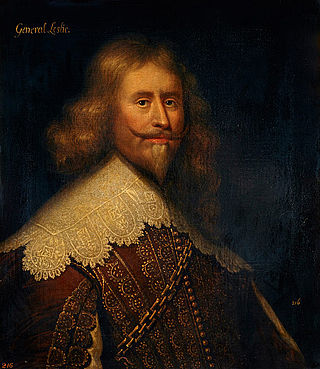
Alexander Leslie, 1st Earl of Leven was a Scottish military officer and peer. Born illegitimate and raised as a foster child, he subsequently advanced to the rank of field marshal in Swedish Army, and in Scotland became Lord General in command of the Army of the Covenanters, a privy councillor, captain of Edinburgh Castle, Lord Balgonie and Earl of Leven. In England he commanded the Army of the Solemn League and Covenant and was senior commander of the Army of Both Kingdoms (1642–1647). Leslie served in the Thirty Years' War, the Bishops' Wars, and most of the English Civil War, fighting primarily in the First English Civil War. Leslie would live a long life, dying roughly at the age of 80 or 81.

David Leslie, 1st Lord Newark was a Scottish military officer and peer. During the Thirty Years' War, he joined in the Swedish Army in 1630 and served under Alexander Leslie. Returning to Scotland in the final days of the Bishops' War, Leslie fought in the English Civil War and Scottish Civil Wars on the side of the Covenanters and Royalists. After the Stuart Restoration, Leslie was raised to the peerage of Scotland as Lord Newark by Charles II of England.

Castle Chanonry of Ross, also known as Seaforth Castle, was located in the town of Fortrose, to the north-east of Inverness, on the peninsula known as the Black Isle, Highland, Scotland. Nothing now remains of the castle. The castle was also known as Canonry or Chanonrie of Ross, the former county.
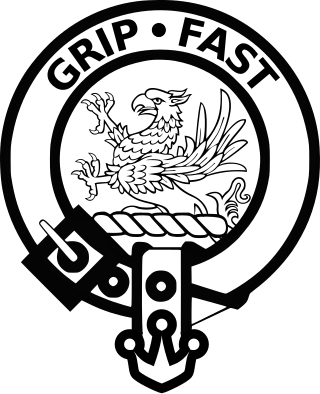
Clan Leslie is a Lowland Scottish clan. The progenitor of the Clan, Bartolf, was a nobleman from Hungary, who came to Scotland in 1067. He built a castle at Lesselyn, from which the clan name derives.
Colonel Robert Munro of Foulis, also known as the Black Baron, was traditionally the 18th Baron of Foulis in Scotland. He was a soldier of fortune, who served in Germany under the banners of Gustavus Adolphus, king of Sweden. It is not certain how he got his epithet of the 'Black Baron', but quite possibly it was from the colour of his hair rather than any perceived martial ferocity. Although this Robert Munro is traditionally 18th Baron and 21st overall chief of the Clan Munro, he is only the 11th Munro chief that can be proved by contemporary evidence.

The siege of Stralsund was a siege laid on Stralsund by Albrecht von Wallenstein's Imperial Army during the Thirty Years' War, from 13 May 1628 to 4 August 1628. Stralsund was aided by Denmark and Sweden, with considerable Scottish participation. The lifting of the siege ended Wallenstein's series of victories, and contributed to his downfall. The Swedish garrison in Stralsund was the first on German soil in history. The battle marked the de facto entrance of Sweden into the war.
Sir George Munro of Culcairn was a Scottish soldier of the 18th century from Ross-shire, Scotland. He commanded the 3rd Independent Highland Company from 1714 to 1716, fought at the Battle of Glen Shiel in 1719, led the 6th Company in formation of the "Black Watch" in 1725, the 8th Company of Black Watch when it was regimented in 1739 and again commanded an Independent Highland Company in 1745–46. He was shot in error in 1746.
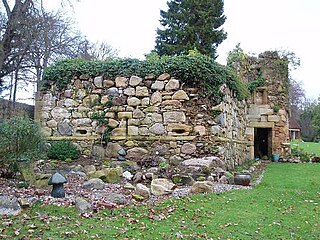
Sir George Munro, 1st of Newmore (1602–1693) was a 17th-century Scottish soldier and member of parliament from the Clan Munro, Ross-shire, Scotland. He was seated at Newmore Castle. Between 1629 and 1634 Munro held command in the Swedish army during the Thirty Years' War, and from 1642 in the Scottish Covenanter army during the Irish Confederate Wars before changing his allegiance to the Royalist cause of Charles I in 1648 during the Scottish Civil War and Irish Confederate Wars.
Robert Mor Munro, 15th Baron of Foulis, and 18th chief of the Clan Munro was a 16th-century Scottish chief. He was known as Robert Mor on account of his large stature. He was the eldest son of Robert Munro, 14th Baron of Foulis. Although this Robert Munro is traditionally 15th Baron and 18th overall chief of the clan, he is only the 8th Munro chief that can be proved by contemporary evidence.
Contullich Castle was a castle located a few miles north-west of the town of Alness, on the eastern side of the county of Ross-shire, Scotland.
Sir Robert Munro, 3rd Baronet of Foulis, 21st Baron and 24th chief of the Clan Munro was a 17th-century Scottish soldier and politician.
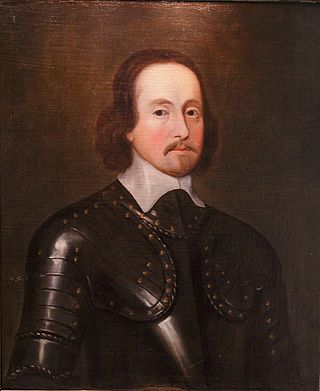
The Battle of Lisnagarvey was fought on 6 December 1649, near Lisnagarvey during the Irish Confederate Wars, an associated conflict of the 1638 to 1651 Wars of the Three Kingdoms. Forces loyal to the Commonwealth of England defeated an army supporting Charles II of England, composed of Royalists and Scots Covenanters.
Sir Hector Munro, 2nd Baronet of Foulis was a Scottish noble and clan chief of the highland Clan Munro. He is also by tradition the 20th Baron and 23rd overall chief of the clan. However, he is actually the 13th chief of the Clan Munro who can be proved by contemporary evidence.

The Munros of Obsdale were a Scottish family and a cadet branch of the Clan Munro, a Highland Scottish clan. Their base was at Obsdale House, situated just north of the town of Alness in the Scottish Highlands. Some of the members of the Munro of Obsdale family were amongst the most distinguished Scottish military officers of the 17th century.

Clan Munro is a Highland Scottish clan. Historically the clan was based in Easter Ross in the Scottish Highlands. Traditional origins of the clan give its founder as Donald Munro who came from the north of Ireland and settled in Scotland in the eleventh century, though its true founder may have lived much later. It is also a strong tradition that the Munro chiefs supported Robert the Bruce during the Wars of Scottish Independence. The first proven clan chief on record however is Robert de Munro who died in 1369; his father is mentioned but not named in a number of charters. The clan chiefs originally held land principally at Findon on the Black Isle but exchanged it in 1350 for Estirfowlys. Robert's son Hugh who died in 1425 was the first of the family to be styled "of Foulis", despite which clan genealogies describe him as 9th baron.
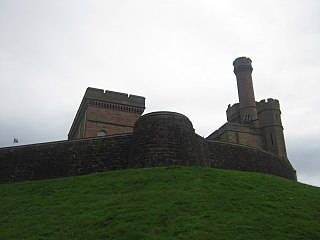
The siege of Inverness Castle took place in 1562. When Mary, Queen of Scots, visited Inverness on 9 September 1562 the gates of the castle were shut in her face by Alexander Gordon upon the orders of George Gordon, 4th Earl of Huntly, who was chief of Clan Gordon and Sheriff of the county. The castle was subsequently besieged by supporters of the Queen.

The siege of Inverness took place in 1649 as part of the 17th-century Scottish Civil War that was, in turn, part of the Wars of the Three Kingdoms.
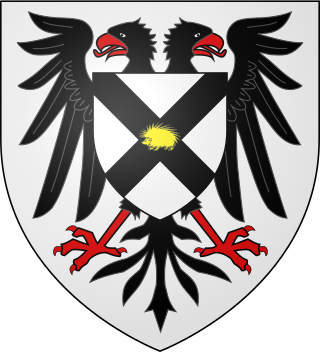
Robert Maxwell, 1st Earl of Nithsdale, was a Scottish nobleman. He succeeded his brother as 10th Lord Maxwell in 1613, and was created Earl of Nithsdale in 1620. General of Scots in Danish-Norwegian service during the Thirty Years' War. A loyal supporter of Charles I and a prominent Catholic, he lost his titles and estates in 1645, dying on the Isle of Man in 1646.

There was a complicated involvement between Scotland and the Thirty Years' War of 1618–1648. Scotland and the Scots were heavily entangled in both the diplomatic and military events which centred on the Holy Roman Empire. There were a number of reasons for this participation.
The Munros of Kiltearn were a minor noble Scottish family and a branch of the ancient Clan Munro, a Scottish clan of the Scottish Highlands.They were seated at Kiltearn House which was a manor house that shared the same name of the parish it was situated in, Kiltearn. In Scottish Gaelic the Munros of Kiltearn are known as the Sliochd-Alastair-Mhic-Uistean. The most famous member of the Munro of Kiltearn family was Donald Monro, High Dean of the Isles.
References
Citations
- ↑ MacKay. (1885). An Old Scots Brigade. Edinburgh. Quoting: Monro, Robert. (1637). Monro, His Expedition with the Worthy Scots Regiment. London.
- 1 2 3 Mackenzie. pp. 210.
- ↑ "Monro, Robert [SSNE 94]". University of St Andrews . Retrieved 12 February 2022.
- ↑ Munro, R.W. (1987).
- 1 2 3 4 Mackenzie. pp. 211.
- 1 2 Mackenzie. pp. 212.
- 1 2 Mackenzie. pp. 213.
- ↑ Mackenzie. pp. 215 - 216.
- 1 2 3 4 5 6 7 Mackenzie. pp. 217 - 219.
- ↑ Steve Murdoch and Alexia Grosjean, Alexander Leslie and the Scottish Generals of the Thirty Years' War, 1618-1648 (London, 2014), pp.47-51.
- ↑ Monro, His Expedition, I, pp.77-78 cited in Steve Murdoch and Alexia Grosjean, Alexander Leslie and the Scottish Generals of the Thirty Years' War, 1618-1648 (London, 2014), p.49
- 1 2 3 Mackenzie. pp. 223 - 224.
- 1 2 3 4 5 Mackenzie. pp. 224.
- 1 2 Mackenzie. pp. 225 - 226.
- 1 2 Mackenzie. pp. 227 - 228.
- ↑ Mackenzie. pp. 232.
- ↑ Murdoch and Grosjean, p.87
- ↑ History of Tantallon Castle electricscotland.com. Retrieved 13 April 2013.
- ↑ Robert Monro - British Civil Wars british-civil-wars.co.uk. Retrieved 13 April 2013.
- ↑ Mackenzie. pp. 240.
- ↑ Robert Monro - Spynie Palace Archived 30 November 2006 at the Wayback Machine mysteriousbritain.co.uk. Retrieved 13 April 2013.
- ↑ Spynie Palace & Mary, Queen of Scots marie-stuart.co.uk. Retrieved 13 April 2013.
- ↑ Domestic Annals of Scotland - Reign of Charles I. 1637 electricscotland.com. Retrieved 13 April 2013.
- ↑ Huntly Castle and the 2nd Marquis - ScotWars scotswars.com. Retrieved 13 April 2013.
- ↑ Lewis (1846), p. 111
- 1 2 3 4 5 6 7 8 9 10 11 12 13 14 15 16 Chisholm 1911.
- ↑ Mackenzie. pp. 243 - 248.
- ↑ Mackenzie. pp. 263.
- ↑ Mackenzie. pp. 264.
Bibliography
Chisholm, Hugh, ed. (1911). . Encyclopædia Britannica . Vol. 19 (11th ed.). Cambridge University Press. pp. 10–11.; Endnotes:
- Carte, Thomas. (1851). History of the Life of James, Duke of Ormonde, (6 vols., Oxford).
- Gilbert, Sir J. T. (1879–1880). Contemporary History of Affairs in Ireland 1641–1652, (3 vols., Dublin).
- Gilbert, Sir J. T. (1882–1891). History of the Irish Confederation and the War in Ireland, (7 vols., Dublin).
- Hill, G. (ed.). (1869). The Montgomery MSS., 1603-1703, edited by (Belfast).
- Mackenzie, Alexander. (1898) History of the Munros of Fowlis , (Edinburgh).
- Murdoch, Steve and Grosjean, Alexia. (2014). Alexander Leslie and the Scottish Generals of the Thirty Years' War, 1618-1648 (London).
- Munro, R.W. (1987). Mapping the Clan Munro. (Published by the Clan Munro Association).
- Scott, Sir Walter. A Legend of Montrose, author's preface
- Spalding, John. (1850). Memorials of the Troubles in Scotland and England, (2 vols., Aberdeen).
- Lewis, Samuel (1846), A Topographical Dictionary of Scotland (Volume I), Lewis